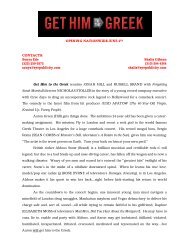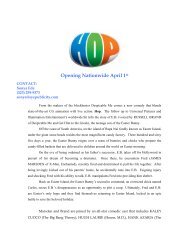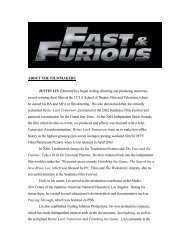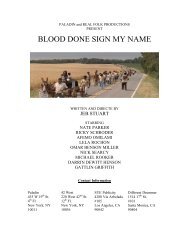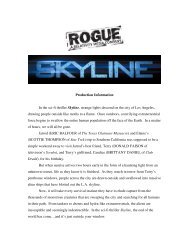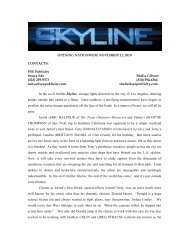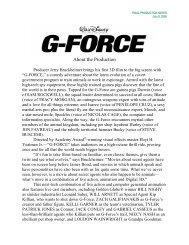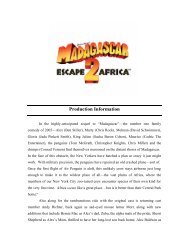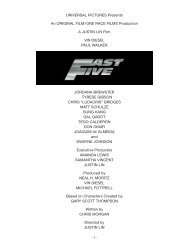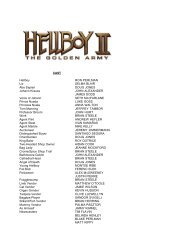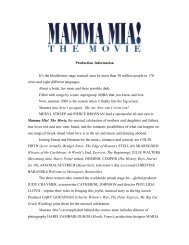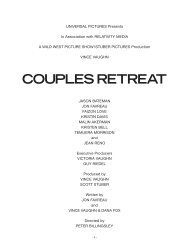Production Notes & Screen Credits - SYE Publicity
Production Notes & Screen Credits - SYE Publicity
Production Notes & Screen Credits - SYE Publicity
Create successful ePaper yourself
Turn your PDF publications into a flip-book with our unique Google optimized e-Paper software.
Team” during a phone call. Though he had not yet secured the rights to the story,Hackett had a solid working relationship with Dick’s estate and wanted to pursueoptioning and developing the project. When the producer pitched Nolfi the concept of“Fate personified” trying to prevent a man from being with the woman he loves, Nolfiwas intrigued. “He got very interested very quickly,” recounts Hackett. “In fact, herequested that we meet that day to talk more.”Though Dick’s work can be both prescient and dystopian, the central conceit of“Adjustment Team”—that Fate is a group of people among us—melded with a love story,struck Nolfi as an original concept for a film that could dig into some of life’s “bigquestions” in a thrilling and compelling way.Flash forward to Nolfi’s work with Matt Damon on Ocean’s Twelve; during thistime, he and Hackett pursued the adaptation of what would become The AdjustmentBureau. They were certain that they wanted Damon as their lead, and Nolfi began towrite the part of his protagonist with Damon in mind. Observes the writer/director:“Matt’s the best everyman that we’ve got, and because of that he’s extremely believablein a love story.”Damon’s interest was piqued by this tale of a man who stumbles on a vast,powerful and unseen world that exists on the periphery of our own. He told thefilmmakers that if future drafts looked as good, he would be ready to join. “George hasbeen a friend and collaborator for a long time,” notes Damon. “He brought this script tome that he’d written on spec…because he wanted to direct it. I was a big believer in himand felt he could do it.”Nolfi took the opportunity to polish the idea before revisiting the project withDamon during The Bourne Ultimatum, which Nolfi also co-wrote. “I got the script to aplace where I thought it was ready for Matt,” Nolfi says. “Once he said he was interestedin being involved formally…it was a back and forth collaborative process.” Together,the colleagues had many philosophical conversations about the material; from thesediscussions came ideas that Nolfi used to improve the arc and build out his story.Damon was impressed with the manner in which Nolfi expanded Dick’s work andmade it particularly relevant for a modern audience. The performer commends: “George
envisioned the role to be played by somebody who was a professional dancer or anactress who had many years of ballet training,” offers Nolfi. But as it turns out, findingthe right actress with the appropriate training, as well as the right chemistry with Damon,was a trickier feat than originally considered.The production auditioned hundreds of dancers from around the world, with Nolfibeing present for dozens of the auditions. “We put on tape eight or nine hundred women,and we found a few good possibilities who were professional dancers,” he remembers.“But at the end of that process, I went to established actresses to see how they played thescenes.”When acclaimed performer Emily Blunt read the script, she instinctively knew aprofessional actress was needed for the part. “I called my agent and said this is trickystuff and an actor should do it,” says Blunt. “If that love and that relationship doesn’twork, you don’t have a movie. That’s what I said to George, rather boldly, and heagreed.”“In one meeting, Emily completely derailed my plans for casting the role,” admitsNolfi. “She came in and read with Matt. We filmed the whole thing, and you could justtell.” After she won the role, Blunt dedicated several months to vigorous dance trainingfor the part. She knew portraying Elise Sellas would be immensely tough.Once her training brought her character’s physicality up to snuff, Blunt found thatbringing the romance to the role of Elise was the fun part. “I thought, ‘Thank God. Nolfihas written a feisty, strong, layered, complicated girl who can hold her own. She’s tough,but she’s vulnerable,” Blunt says. “There was a lot to play with; the dialogue was witty,and the connection they have and how they fell in love didn’t seem contrived.”“David and Elise’s first encounter is unusual. The romance and the spark of thescene is fought against the backdrop of sinks and toilets,” the performer laughs. “It setsus up with the situation that you can’t help whom you’re attracted to, and you certainlycan’t help the situations or environments in which you find yourself attracted to thisperson.”David informs Elise that he has just lost the election, and she unexpectedlyinspires him with genuine words of encouragement. “David’s just about to go make hisconcession speech and he’s at a point where he feels like he’s lost it all,” says Blunt.
‘Well, he wasn’t what I would have chosen. He wasn’t what I wanted at all, but Icouldn’t help myself.’ I’ve thought about that a lot. Because that’s the destiny, isn’t it?Where your mind doesn’t want something, but you have to do it anyway.”The Art of Politics:Damon as NorrisThe production was able to leverage Matt Damon’s celebrity to further theauthenticity of David Norris’ life in The Adjustment Bureau. During the shoot, Damonwas asked to take part in President Clinton’s Global Initiative. Recounts Hackett: “Wehad the idea, and the Clinton people thought it was fine, that Matt would go in wardrobeas David Norris, who would logically be at this type of an event. We could get himinteracting with President Clinton and other heads of state.” A skeleton crew, led bycinematographer John Toll, was granted the security clearances necessary to followDamon around the event documentary-style, while producer Moore worked to persuadeother world leaders and politicians to appear in the film as well.The key crew even had a fortuitous encounter with President Obama’s advanceteam at The Waldorf Astoria hotel during the first week of shooting, and it secured somebonus technical advice as it prepared to shoot the concession speech scene. Keylearning? Lose a Lucite podium in favor of a more traditional one.Damon’s publicity tour stops to promote The Informant! also benefited TheAdjustment Bureau. The Informant! was being released just as production began, and soDamon’s appearance on The Daily Show With Jon Stewart became another opportunity toshoot a campaign-stumping scene for David.“The way people react to Matt Damon is not unlike how they would react to acelebrity politician,” says Hackett. “We used that overlap to our advantage. He can walkdown the streets of New York and people recognize him and camera phones come out.But that was value for the movie because, again, they are reacting to Matt Damon, notdissimilar to how we would like them to be reacting to the character of David Norris.”Another aspect of this character that plays well into Damon’s filmic experience isthe physicality of stunts. Much like Jason Bourne’s tireless athlete, David Norris finds
himself literally outrunning Fate. “There are a number of corridors and stairwells,lobbies and elevator banks in this film,” states production designer Kevin Thompson. AsDavid navigates Manhattan, eluding agents and eventually making a final dash into theheart of The Bureau itself, he is running for his life.As an actor who enjoys performing his own stunts, Damon had athletic ability tospare while playing Norris. But that was occasionally frustrating to the Ginger Rogers tohis Fred Astaire. “Matt’s a good runner. He’s fast, annoyingly fast,” laughs Emily Blunt,who was forced to keep up with him while she wore high heels for many of hercharacter’s chase scenes with David.Perhaps the only element in the film that seems to be a departure from Damon’sprior acting roles is the love story. “This is the most romantic lead I’ve ever had,” admitsDamon. “It was definitely new territory.”The Art of Dance:Training BluntFrom the beginning of principal photography, Blunt was upfront about her lack offormal dance training. “I was honest. I’ve never danced in my life,” she says. “I metGeorge, and I said, ‘I’ll work my ass off for you if you let me do this.’”The performer immediately asked to meet with the film’s choreographer,BENOIT-SWAN POUFFER, from Cedar Lake Contemporary Ballet, which wouldbecome the actual company that Nolfi wrote into the film’s script.Founded in 2003 by Nancy Laurie and artistically directed by Pouffer, CedarLake Contemporary Ballet of New York City has a core group of 16 dancers, and itemphasizes acquiring and commissioning new works by the world’s most sought-after,emerging choreographers. With performances often incorporating multimediapresentations, Cedar Lake is known for its daring, athletic movements and its integrationof ballet into contemporary and popular forms.When Nolfi approached Pouffer to have his company involved in the film, Nolfidiscussed a female dancer in the role of Elise. Remembers Pouffer of his earlierconversations with Nolfi: “I said, ‘Okay, but make sure that it is a dancer because I’ve
seen many movies fail because it’s difficult to show how a dancer is.’ Then a month laterthey said, ‘We found the actress: Emily Blunt.’ I said, ‘She’s not a dancer. What are wegoing to do?’ But it’s been such a pleasure. Emily came in full-force, and I felt that shewanted to get the style and the behaviors; she’s done an amazing job.”Pouffer’s objective was never to make Blunt a trained dancer. He felt the bestway to approach teaching a non-dancer to perform would be to draw the parallel to heracting skills. “I was here to explain to her that some dancing is not necessarily done bydancers. It’s movement and understanding phrasing and theatricality when you dance,”the choreographer explains. “It’s like learning dialogue, learning a script.”In fact, he used the emotional tones of the screenplay to inform his choreographyfor Elise’s numbers. “The solo scene was interesting to work with Emily because it’s amoment where she’s asking herself some questions,” he says. “She’s going throughsomething. So we had to, movement-wise, express the step of anxiety.” Throughout allthe training, Blunt was game for the ideas her instructor aimed to execute through hermovements. “Emily’s special,” Pouffer comments. “She’s strong. She’s not scared.”Producer Carraro, who had recently worked with Blunt in London on TheWolfman, was confident that she had the work ethic and athletic ability to take on thechallenge. Still, the prospect of training to become Elise was initially intimidating forBlunt, who not only had to achieve the precision and form of a professional dancer onscreen, but also didn’t want to disappoint the Cedar Lake professionals whom she wouldbe representing. With Pouffer instructing her on dance and a personal trainer workingher out for hours a day, six days a week, Blunt began an entire lifestyle overhaul thattransformed her body into that of a dancer’s.“The training was unreal. I hurt every day. It’s one thing to say, ‘I’ll do it foryou,’ but it’s another thing to actually do it,” Blunt says of her promise to Nolfi. “It washell to learn at first, and then it became invigorating, and one of the biggest, lifeexpandingexperiences I’ve ever had.”Moore notes that since Blunt was cast in late July 2009 and the film beganshooting in New York in September, she didn’t have many months to train. Though theperformer did work with body doubles, and films have the luxury of shooting at specific
angles and cutting around talent in postproduction, many of the cast and crew admit thatBlunt rarely relied on visual crutches to express her character in motion.Remembers Nolfi: “Emily came out here a couple months before production andshe was dancing five or six days a week and working out, taking it seriously on thephysical performance level.” The director also stresses that Blunt was not learningsimply standard ballet techniques. “It’s ballet-based contemporary dance, so it doesn’tlook like your mother’s or father’s ballet. It looks like modern dance, and it is set tomodern music; you couldn’t possibly do this dance without a lot of ballet training.”Her co-star agrees with his director’s assessment. “I’m normally the actor whoends up having to do a boatload of training for things,” says Damon. “On this one, I justsat back and watched Emily; she was just so great and utterly believable.”Bureau Headquarters:On Location in ManhattanAside from the fact that David Norris is a congressman from the area, New YorkCity represented much within the context of the film. “New York is central to my visionof the story for a number of reasons,” Nolfi says. “If there is an American city that standsfor the most powerful city—the city where the headquarters of Fate would be—it’s got tobe New York.“Aside from filmmaking, my favorite art forms are architecture and dance,” hecontinues. “So by setting it in New York and constructing in my head an AdjustmentBureau that was a big, massive, tall building—that allowed me to play out my interests inarchitecture. Then, Elise allowed me to get into the dance world. Both of those thingsare centered, at least in the U.S., in New York City.”To build the visual style of The Adjustment Bureau headquarters—a timelessstructure that exudes power—the team leaned on production designer Thompson andlocation manager ROB STRIEM to create a pastiche of rooms, roofs, stairwells andfaçades from some of New York’s most stylized buildings. Reflects producer Carraro:“The richness of these practical locations are particularly hard to duplicate, and weneeded to access some of New York’s toughest places to gain permission to film.”
“When I first met with George, he had only a half dozen reference pictures, butthey were all strong imagery of a particular era in New York—moody and graphic,” saysThompson. “Those images, along with the script, immediately gave me a lot ofinformation about where he was coming from.”Specifically, Nolfi drew inspiration from notable structures throughout historythat implied spiritual weight. “If you think about the history of architecture, Greektemples or the Vatican, or large-scale buildings in which human beings feel small, theyare suggestive of otherworldly power,” Nolfi explains. “I went out of my way to pick themost beautiful spaces I could find to suggest that if they controlled things…this is whatthat world would look like.”“The Adjustment Bureau itself is an amalgamation of different locations,” saysStriem. “I worked with Kevin to piece together rooms and spaces, interiors and exteriorsthat are architecturally appropriate but might be on opposite ends of New York. In themovie they comprise this singular office building. It’s been a challenge to make it alllook correct to the period of architecture and the nature of the location.”As he is quite familiar with New York, Nolfi already had many of the locations inmind, whereas other locales he happened upon while walking to lunch around the city. Ifa structure struck him as beautiful and of a similar style or era to the other buildings hewas considering for his Adjustment Bureau palette, it was marked for scouting.So what exactly makes up the palette of the firm? “It’s a lot of white or tanmarble, with dark wood similar to 1910, 1915 New York,” Nolfi clarifies. “It’s not quiteArt Deco, because Art Deco announces itself, like the Chrysler building. It’s not theseheavy baronial giant columns. It’s got this soaring feel that Art Deco has. But then it hassome of the heavier features…Beaux Arts is what that would be called. We just found away to mix them.”“The physical structure of The Adjustment Bureau is a made-up building thatexists in the middle of Manhattan, and it is a composite of six different great locations inthe city that we cobbled together,” explains Thompson. “We took the base of a buildingin Madison Square Park. We took the roof of a building in Midtown. We took the lowersections of the New York Public Library. We were in the U.S. Custom House downtownfor some of the hallways and stairwells. We took pieces that all represented the
grandness and perfection that was found in a certain period of architecture in the city, andwe married them together.”Thompson elaborates on creating the world of The Bureau from existinglocations: “Quite often in the spaces and rooms, we took out the details such as exit signsor light switches. We wanted to represent the space in its purest form without the sort ofthings that have been added in the last few years.”Based on the sheer number of locations, shooting in the city proved to be a bit ofa behemoth. Says Striem, who has worked on such recent location-heavy New Yorkprojects as Across the Universe, The Interpreter and The Brave One: “There are probablymore locations on this film than any that I have ever done in New York. We had about85 locations during a 70-day shooting schedule. We were rarely in one place for anylength of time, so this was a paramilitary operation.”Some of the locations used for pivotal scenes include the roof of 30 RockefellerCenter, also known as Top of the Rock; the New York Public Library; the historicalCustom House in lower Manhattan (home to a Native American museum and offices ofHomeland Security); the Waldorf Astoria hotel; 60 Centre Street courthouse; Fort TryonPark and its New Leaf Restaurant & Bar; the South Street Seaport neighborhood; theFulton Ferry Landing in Brooklyn; the field at Yankee Stadium; the performance andrehearsal space of the actual Cedar Lake dance company in Chelsea; Madison SquarePark; and the streets of the West Village. Scenes were even filmed on the Hudson Riveron a Circle Line ferry that moved up and down alongside Manhattan’s west side.Hackett appreciated the unfettered access to some of New York’s mostspectacular landmarks the team was given. In fact, for a pinnacle moment in which Eliseand David find themselves on a huge, expansive roof of The Adjustment Bureau, theproduction had yet to find a viable location. Nolfi and Hackett happened to besightseeing on the roof of 30 Rock with family when they realized they had found theperfect locale.“Initially we were looking for size,” Hackett explains of 30 Rock’s modest roofspace. “By doing the opposite of what we tried to do initially, we found something moreuseful and dramatic. The location that we found suggested something that we weren’tthinking of when we first went through the movie and blocked it out.”
Because so many locations were put together to represent singular areas, muchattention had to be paid to continuity. “George has been diligent about wanting to begeographically correct,” Striem observes. “Even though the agents are moving throughdoors and crossing town, Nolfi’s been conscious not to make it incorrect. We’re notgoing downtown when we’re supposed to be progressing uptown in pursuit.”Accomplished cinematographer John Toll was integral to capturing this unseenmagic of the city. “Toll was a crucial piece of the puzzle for how the film looks,”stresses Moore. “The movie has multiple balls that are in the air, and the audience isgoing to need to seamlessly move in between the action and the love story.”Beyond the singular beauty of New York City, however, the story of TheAdjustment Bureau called for locations and rooms that could not possibly exist in the realworld. Though Nolfi aimed to keep the look as realistic as possible, and rely on actualfootage when he could, there was a point when the production needed to bring in thespecial effects. Remarks Hackett: “It’s the forward edge of filmmaking in terms ofwhat’s done and how. Whether it’s visual effects or real shoots, miniatures or acombination or composite…there are 15 ways to skin a cat.”To create the seemingly impossible Escher-like stairs, hallways and rooms of TheAdjustment Bureau’s main offices, Nolfi relied on Thompson to build new sets, as wellas on visual effects supervisor Mark Russell to create the unimaginable and add on whereneeded. Russell’s previous work on another Philip K. Dick-inspired film, MinorityReport, assured that he was familiar with the author’s unique sensibilities.Because the agents travel through doorways throughout the city, the art directioncrew had to make sure how the men moved made sense. “A lot of our concentration andour construction involved doorways—like combining this side of this door with that sideof that door,” Russell explains. “Which way does it swing? Which door exists in reality,and which door do we have to create on a location so that it will match up with what’ssupposed to be on the other side?“My favorite thing is weaving it all together and making sure that it feelsseamless,” Russell continues. “There are other locations that we built to look like they’vealways been there. Those are the things I’m most proud of…when they disappear intothe tapestry of the movie.”
Many times the perfect visual location had layout issues that would impede thenarrative of the scene. For example, though the roof of 30 Rock provided the perfectexpanse for the climatic scene with David and Elise, reaching the top of this buildingafter a stairwell chase could not be done at 30 Rock.“We built a stairway that’s on top of The Adjustment Bureau,” Thompsonexplains, “with a big green screen around it. Then we took sections of that and put it onthe roof of our building on which we shot the climatic scene. So, a lot of the constructionwe did was to tie in different locations to one another, supported by visual effects.”Perhaps the greatest feat for both Thompson and Russell was creating the PlanRoom, the library of The Adjustment Bureau. In the story, this library exists on the 90 thfloor of the fictional New York building. But a room in The Adjustment Bureauheadquarters cannot be understood logically through the lens of a human eye. Much likethe roof-staircase trick, Russell and Thompson needed to create an infinite library. Thisneeded to be comprised from only one shot of an empty room at 20 Exchange Place inNew York that was chosen for inspiration. It also needed to work within the context of achase scene in which Elise and David are running from agents.The intended effect of playing visual tricks on the characters, as well as on theaudience, is to build the scope of The Adjustment Bureau beyond human comprehension.“The idea is that this is one section of a large room. We only had one section to actuallyshoot,” explains Russell of the book-filled space that the crew replicated ad infinitum.“It’s 13 setups essentially, from different angles and different pieces that ultimately cometogether to make the Plan Room,” he continues. “This is a fast sequence, but it seemsmuch more elaborate than it is.”The Suit Makes the Man:Wardrobe of the FilmTo complement the carefully selected architecture within the world of TheAdjustment Bureau, Nolfi knew that the agents’ wardrobe should also visually set themapart from humans…without drawing too much attention to their presence. The director
decided to express this mystical notion with the most unassuming of apparel: timelesssuits and hats.In theory, agents of The Adjustment Bureau dress in clothing similar to the outfitsworn by the humans that they shadow. Because David Norris is a well-heeled politician,the agents in his life mirror the more formal attire.“The idea was to have great-looking suits and hats, but not to have them indicateany one specific time period,” says Hackett. “It could be ’40s, it could be ’30s and itcould be today. There’s something retro but also modern about them. It’s evocative andadds to their otherworldly element without having them be exaggerated angels or demonswith nonanthropomorphic bodies.”The powers of The Adjustment Bureau are a clever function that Nolfi instilledinto his visual symbols: the ability of agents to travel through the fabric of the city underthe radar and to adjust humans. “In order to use their higher powers, agents have to havea hat on,” Nolfi says. “Inside all the hats there is a power ranking; the higher-upexecutives have hats that allow them to use more power to influence humans.“It also fits nicely with the architectural palette of the movie because there’s thismorphed combination of early 1900s New York architecture,” Nolfi adds. “In that periodin men’s dress, all men wore hats.”To bring the director’s vision of crisp, timeless suits and stylish, yet unassuminghats to life, costume designer Kasia Walicka Maimone was tapped to cull the looks froma much more dapper time. As Walicka Maimone remembers, few words were spokenbetween her and Nolfi when they first met, as they simply browsed and selected imagesfrom her inspiration boards, coming together on a vision for the costumes.“I had plenty of photographs, so we could both find our visual language just byresponding to those images. That’s how we started building the vocabulary for the film,”she explains. “George was interested in portraying reality as it is—close to reality. Allthe characters were not completely real, but they had to be rooted in reality.”For a timeless look that could be pulled off in the modern day, they began lookingat 20 th -century styles. “We looked at a lot of references from period clothing, beginningat about 1910, when men’s contemporary clothing language was invented. All the suitsare trim in fit, and we created this quiet palette of grays and dark greens, with streamlined
silhouettes. We felt that for The Adjustment Bureau, all the guys needed to have thatfunction of being able to blend in among the street crowd.”For the suits to conform with the hats’ nod to a higher power, Nolfi and WalickaMaimone considered what touches they could add. “We kept thinking, ‘What is the colorthat calls for all the powers that The Bureau is supposed to represent?’ Intuitively, Ithought it needed to be green, and that green needs to trickle down all through TheAdjustment Bureau. It needed to stay within that quiet palette.”However, the look of the agents also has an ominous and militaristic feel. Just aswhen one visits the inside of The Bureau, there is a clear, regimented order to how theyoperate. “The leading vocabulary for us was that The Adjustment Bureau has a militaryelegance: it’s a streamlined, clean-lined; everything is pressed and strict,” WalickaMaimone explains. “As George referred many times, there is an underlying military-likestructure in The Adjustment Bureau, and the ranks are clear.”The costume team spent weeks researching uniforms of military forces fromthroughout history to find subtle inspiration for the agents’ outfits, as well as for the moreintimidating Intervention Team of The Bureau. “We knew that we were not going to bein the world of suits with the Intervention Team, because it would take us out of thevocabulary of the film of what needed to feel immediate and instantaneouslythreatening,” Walicka Maimone elaborates.To customize each agent’s suit, she used material details such as scarves andhandkerchiefs. The team also took care to distress each individual agent’s hat to give theappearance of a well-worn fedora that has withstood the test of time. The designerreflects: “There is the humanity factor that comes into each of the characters. So eachcharacter has slightly different versions of the outfit.”For the characters of David and Elise, Walicka Maimone developed wardrobesinspired by their professions. In her mind, American politicians have their own uniform:“It was a clear vocabulary that we created for the world of David and the politiciansaround him: a dark navy suit with a solid tie, a conservative and classic suit. Navy blues,blues and khakis—that became the world of David.”Elise, however, comes from the opposite end of movement and expression. “Sheneeded to have this dramatic contrast to the word of the politicians, of their super-
structured uniform look,” the designer explains. To accentuate Elise’s fun and freeattitude, Walicka Maimone relied on vintage dresses with modern touches and addedadditional expression through color.To create Elise’s costumes for her dance pieces, Walicka Maimone workeddirectly with the Cedar Lake company. The opportunity was exciting for the designer,who views Cedar Lake as “rebels of the ballet world,” with an urban, street sensibility totheir style. “That process was fun because we knew that we wanted to acknowledge thevocabulary of that contemporary dance company,” says Walicka Maimone. “Wecollaborated with Swan and with George to create this flow, but at the same time, hardedge,modern, sculptural look for the company.”****Universal Pictures and Media Rights Capital Present A Gambit Pictures<strong>Production</strong>—In association with Electric Shepherd <strong>Production</strong>s—A Film by GeorgeNolfi: Matt Damon in The Adjustment Bureau, starring Emily Blunt, Anthony Mackie,John Slattery, Michael Kelly and Terence Stamp. Casting is by Amanda Mackey &Cathy Sandrich Gelfond. The visual effects supervisor is Mark Russell, and the costumedesigner is Kasia Walicka Maimone. The Adjustment Bureau’s associate producer is EricKripke, and its co-producer is Joel Viertel. The romantic thriller’s music is by ThomasNewman, and its editor is Jay Rabinowitz, ACE. The production designer is KevinThompson, and the director of photography is John Toll, ASC. The Adjustment Bureau’sexecutive producers are Isa Dick Hackett and Jonathan Gordon. The producers areMichael Hackett, George Nolfi, Bill Carraro, Chris Moore. It is based upon the shortstory “Adjustment Team” by Philip K. Dick. The film’s screenplay is by George Nolfi,and it is directed by George Nolfi. © 2010 Universal Studios.www.theadjustmentbureau.com



